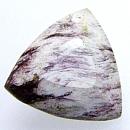|
ClassicGems.net |
|
|
 |
|
Alunite |
|
|
Discovered in 1824; IMA status: Valid (pre-IMA; Grandfathered) |
|||
|
|
|
Chemistry |
|
|
|
|
|
KAl3(SO4)2(OH)6 |
|
|
|
Potassium Aluminum Sulfate Hydroxide |
|
Molecular Weight: |
414.21 gm |
|
Composition: |
Potassium |
9.44 % |
K |
11.37 % |
K2O |
|
|
Aluminum |
19.54 % |
Al |
36.92 % |
Al2O3 |
|
|
Hydrogen |
1.46 % |
H |
13.05 % |
H2O |
|
|
Sulfur |
15.48 % |
S |
38.66 % |
SO3 |
|
|
Oxygen |
54.08 % |
O |
|
|
|
|
|
100.00 % |
|
100.00 % |
= TOTAL OXIDE |
|
|
|
||||
|
Classification |
|
|
|
|
|
Sulfates |
|
|
6/B.11-20 |
|
|
|
7 : SULFATES (selenates, tellurates, chromates, molybdates,
wolframates) |
|
Related to: |
Alunite Supergroup. Alunite Subgroup. Natroalunite - Jarosite - Beaverite Series. |
|
Members of Group: |
Alunite Supergroup: Beudantite Subgroup, Crandallite Subgroup, Florencite Subgroup, Jarosite Subgroup. Alunite Subgroup: Alunite, Ammonioalunite, Natroalunite. |
|
Varieties: |
None |
|
Synonyms: |
Aluminilite, Alumstone, Calafatite, Ignatiewite, Kalioalunite, K-Alunite, Lœwigite, Lowigite, Lœvigite, Newtonite |
|
|
|
|
Crystal Data |
|
|
|
|
|
Crystals typically pseudocubic or tabular with flat vicinal rhombohedra, to 1 cm; fibrous to columnar, porcelaneous, commonly granular to dense massive. |
|
|
None |
|
|
|
|
|
Physical Properties |
|
|
|
|
|
Perfect on [0001] |
|
|
Conchoidal to Uneven |
|
|
Brittle |
|
|
3.5 - 4.0 |
|
|
2.60 - 2.90 (g/cm3) |
|
|
None |
|
|
Barely Detectable; GRapi = 136.78 (Gamma Ray American Petroleum Institute Units) |
|
|
Other: |
Insoluble in water. |
|
|
|
|
Optical Properties |
|
|
|
|
|
Colorless if pure; may be White, pale shades of Gray, Yellow, Red, to Reddish Brown from impurities. |
|
|
Opaque, Translucent, Transparent on thin edges |
|
|
Vitreous; somewhat Pearly on [0001] |
|
|
1.572 - 1.592 Uniaxial ( + ) |
|
|
0.0020 |
|
|
None |
|
|
None |
|
|
Other: |
Strongly pyroelectric |
|
|
|
|
Occurances |
|
|
|
|
|
Geological Setting: |
Formed between 15º C and 400º C by the action of sulfate, which may be generated from pyrite or solfataric action, on aluminous rocks, commonly accompanied by kaolinitization and silicification. |
|
Common Associations: |
Diaspore, Gypsum, Halloysite, Kaolinite, Pyrite, Quartz |
|
Common Impurities: |
Na, Fe |
|
Type Locality: |
Allumiere Quarries, Allumiere, Rome Province, Latium, Italy |
|
Year Discovered: |
1824 |
|
View mineral photos: |
|
|
|
|
| Unusual Gem Categories |
|
|
|
|
|
Radioactive Gems |
|
|
|
|
|
More Information |
|
|
|
|
|
|
|
|
|
|
|
Alunite, also known as Alumstone, is a source of the chemical known as alum and is a rock-forming mineral. Alunite forms from the action of sulfuric acids upon potassium rich feldspars in a process called "alunitization". Alunite can easily be mistaken for Dolomite and Calcite. Alunite is named from the Latin word alunit for Alum. Alum is a chemical compound, usually a hydrated double sulfate salt of aluminium. Sources of Alunite are Marysvale, Utah; Red Mountain, Custer County, Colorado; Goldfield district, Nevada, USA; and Tolfa, Italy. |
|
|
Alunite gems for sale: We have not photographed our Alunite gems. Please check back soon. |